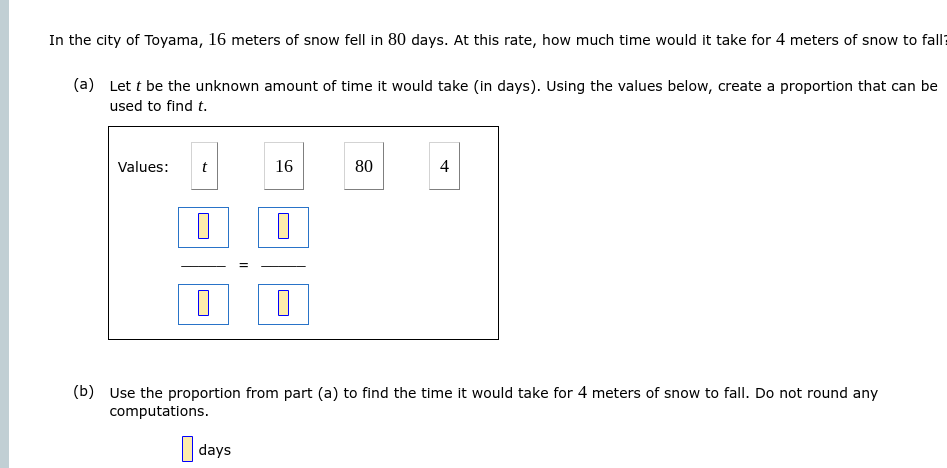In the city of Toyama, 16 meters of snow fell in 80 days. At this rate, how much time would it take for 4 meters of snow to fall? (a) Let t be the unknown amount of time it would t... In the city of Toyama, 16 meters of snow fell in 80 days. At this rate, how much time would it take for 4 meters of snow to fall? (a) Let t be the unknown amount of time it would take (in days). Using the values below, create a proportion that can be used to find t. (b) Use the proportion from part (a) to find the time it would take for 4 meters of snow to fall. Do not round any computations.

Understand the Problem
The question is asking to solve two parts related to the rate of snowfall in Toyama. In part (a), it requires setting up a proportion to find the unknown time, t, for a given snowfall amount. In part (b), it asks for the calculation of the time it would take for 4 meters of snow to fall based on the proportion established in part (a).
Answer
$20$ days
Answer for screen readers
The time it would take for 4 meters of snow to fall is (20) days.
Steps to Solve
- Set Up the Proportion for Part (a)
We know that 16 meters of snow fell in 80 days, and we need to find out how long it takes for 4 meters of snow to fall. We can set up the proportion as follows:
$$ \frac{t}{4} = \frac{80}{16} $$
- Simplify the Proportion
Next, simplify the fraction on the right side of the equation:
$$ \frac{80}{16} = 5 $$
So our equation now looks like this:
$$ \frac{t}{4} = 5 $$
- Solve for t
To isolate (t), multiply both sides by 4:
$$ t = 4 \times 5 $$
- Calculate t
Now calculate the value of (t):
$$ t = 20 $$
This means it takes 20 days for 4 meters of snow to fall.
The time it would take for 4 meters of snow to fall is (20) days.
More Information
This problem illustrates how to use proportions in real-world scenarios related to rates, such as snowfall rates. Understanding proportions helps in making comparisons and solving for unknown variables.
Tips
- Forgetting to simplify the fraction in the proportion, which can lead to incorrect calculations.
- Misapplying the multiplication when trying to solve for (t). It's important to keep proper track of what you multiply on both sides of the equation.
AI-generated content may contain errors. Please verify critical information